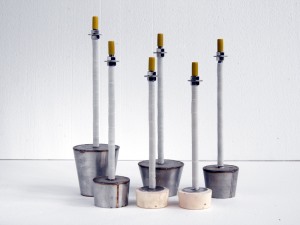Causes of damage to ventilation bricks
In the process of these operations, the damage of the breathable brick is the result of the action of various factors, mainly the erosion and wear of the mixed high-temperature molten steel, the effect of corrosion and infiltration, the effect of thermal stress caused by the blowing of cold air, and the blowing of oxygen to clean the surface after turning over the slag. The ultra-high temperature and strong oxidation at the time of circulation, the rapid cooling and rapid heating of cyclic use constitute heat shedding, slag corrosion, etc.
1) Erosion and wear effects. When the ladle is blown and drilled, the air flow and molten steel are mixed together, and the turbulent flow formed by the mixing of the air has strong shearing, scouring, and abrasion effects on the breathable bricks and aggravates the corrosion of the steel waves on the breathable bricks. At this moment, the ventilation The damage degree of the brick depends on the argon blowing pressure, the total time, and the gas flow. When the ladle capacity is large, the static pressure of the molten steel is large, and the gas pressure required for air blowing is large. If it is increased, the blowing pressure will also be increased, which will also aggravate the damage to the breathable brick.
2) Thermal stress. On the working surface of the breathable brick, especially the refractory material with 4 weeks of the air outlet, one side is in contact with molten steel up to 1600°C and 1700°C; High thermal stress leads to cracks. Breathable bricks are refractory materials that are used many times, and they are periodically quenched and heated, which is easy to crack and fall off near the working surface.
3) Oxygen blowing and cleaning. After the ladle is poured and the slag is turned over, the air-permeable bricks should be cleaned by blowing oxygen to remove the residue on the working surface to ensure the cleanliness of the working surface and the smooth flow of the gas passage. However, excessive cleaning during oxygen blowing will cause Burning to the breathable brick, ultra-high temperature (above 2000C) and strong oxidation have great destructive power on the breathable brick. This damage has a great relationship with the operating conditions.
4) Corrosion. It is mainly due to the corrosion damage of the ventilating plug formed by the invasion of molten steel and the penetration of the molten steel slag wave on the working surface of the ventilating plug to form a reactive metamorphic layer, and then the structure falls off. When the infiltration is serious, the air passage will be blocked, and it will be lowered and blown open. rate and service life.
5) Defects in the function of the seat brick. The seat brick is used in cooperation with the ventilation plug, and the operating conditions are the same: high temperature operation, infiltration of low alkalinity slag, forced mixing, intermittent operation, large temperature change, thermal detachment and structural detachment. If The seat brick corrodes faster than the breathable plug during use, and exposing the breathable plug to molten steel will accelerate the damage of the breathable plug. Therefore, the function of the seat brick is required to meet high temperature corrosion resistance, shedding resistance and wear resistance.

Related News
- Introduction of construction method of ramming material in intermediate frequency furnace
- How to choose the material of furnace lining
- The difference between rammer and castable
- Application direction of intermediate frequency furnace refining
- Introduction to the construction method of dry ramming material
- Do you know the production process and control points of breathable bricks?
- The application of argon blowing technology at the bottom of the intermediate frequency furnace
- Method for prolonging service life of intermediate frequency furnace lining
- In addition to diffused breathable bricks, there are those types of breathable bricks
- What are the advantages of coil cement
- Selection of lining materials for intermediate frequency furnaces
- Matters needing attention in the knotting process of wear-resistant ramming material
- The composition characteristics of ramming material
- How to improve the temperature resistance of the intermediate frequency furnace lining
- Application and classification of breathable bricks
- How to improve the temperature resistance of intermediate frequency furnace lining
- How to properly apply ramming mix
- How to improve the service life of breathable bricks
- Sintering method of intermediate frequency furnace lining
- What are the requirements for the production materials of breathable bricks?


